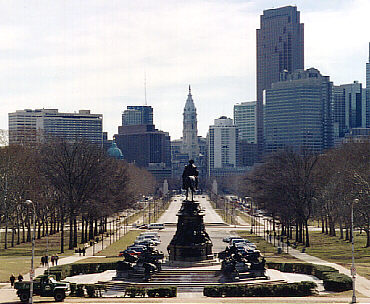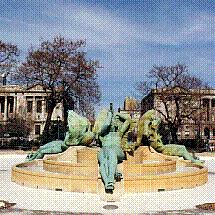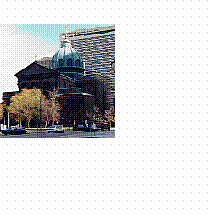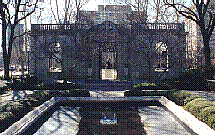| |
Benjamin Franklin Parkway
The result of efforts starting as early as 1884 to reconstruct a gridiron city pattern into something of the image of the City of Light, the great axial avenue, stretching from City Hall to Fairmount Park, placed on the city map in 1903, was studied by such men as Cret, Eyre, Kelsey, Medary, Trumbauer, and Frenchman Jacques Gréber, who prepared the final designs in 1917. This final solution bears a surprising resemblance to Lutyen's plan for New Delhi, begun a few years previous. Construction of the project started in 1917 and took only two years to complete.
Edward Teitelman and Richard W. Longstreth, Architecture in Philadelphia: A Guide (Cambridge, MA: The MIT Press, 1981), p. 109.

|
Philadelphia's Benjamin Franklin Parkway as Virtual Place
The model for Philadelphia's Benjamin Franklin Parkway, a 12 lane tree-lined boulevard linking the city center and Fairmount Park, was the Champs-Elysees of Paris. This grand street, like the one in Paris, was to accommodate all kinds of outstanding civic and religious institutions. Although the entire scheme was not carried out as planned, the Parkway nonetheless manages, in part, to evoke the character of Paris and other capital cities of Europe. Like Hadrian's Villa, moreover, the Benjamin Franklin Parkway is an unanticipated and uncommonly "real" prototype of virtual reality in that it manifests an environmental facsimile and effects a geographic displacement.
The centerpiece of the Parkway is Logan Circle, which is one of Philadelphia's original five squares geometrically transformed. As a prominent point in the Parkway plan, Logan Circle is the focus of many civic buildings, including the Free Library of Philadelphia by Horace Trumbauer and the Municipal Courts by John T. Windrim, which as twin buildings replicate the twin palaces facing the Parisian Place de la Concorde. There is the likelihood that the choice to embellish the French-modeled Parkway with more Parisian themes came from the black architect Julian Abele, Trumbauer's chief designer, whose return from a trip to France came shortly before the drafting of the Free Library's design.
The buildings surrounding Logan Circle do not only evoke Paris, however. The panoramic outlook stemming from the Circle presents a number architectural spectacles: the Cathedral of SS. Peter and Paul recalls Renaissance Italy; the view towards Philadelphia's City Hall offers a slice of a modern metropolis; and the portico of the Franklin Institute calls to mind the grandeur of Imperial Rome.
Looking in the opposite direction from the city, the Parkway opens as a grand boulevard leading to the temple-like Philadelphia Museum of Art.
Halfway between Logan Circle and the Museum of Art is the Rodin Museum, which is another virtual piece of France in that the gate to the museum's forecourt is a replica of the Chauteau d'Issy reconstructed by Rodin for his own home in Meudon, France.
At the head of the Parkway, and looming high on the hill called Faire Mount, is the Philadelphia Museum of Art, which is also by Horace Trumbauer. Besides traveling to France, Julian Abele, Trumbauer's chief designer, also traveled to Greece, from which he returned with the idea of building three temples on a solid rock base. Along with bringing a virtual Acropolis to the Parkway, Abele's traveling and subsequent building are also reminiscent of Hadrian's travels and the Emperor's subsequent building activity at Tivoli.
| |



|
| |
|